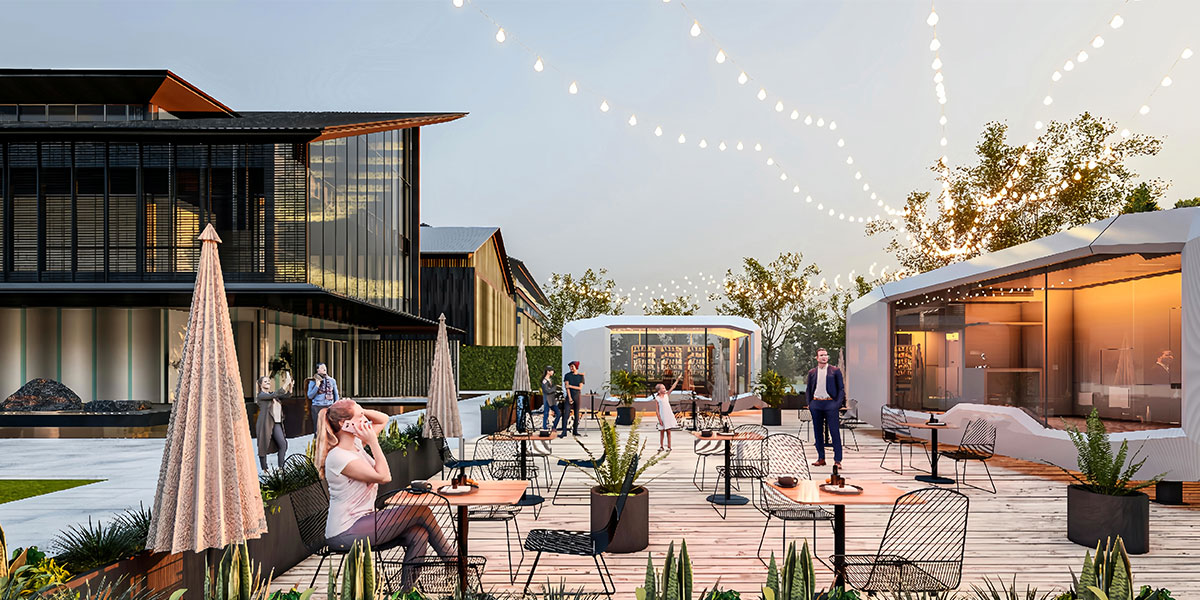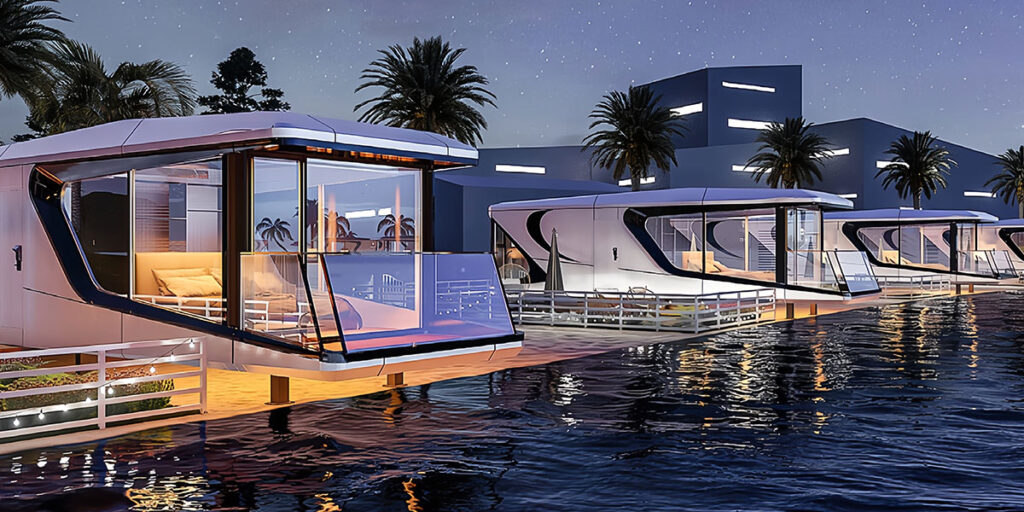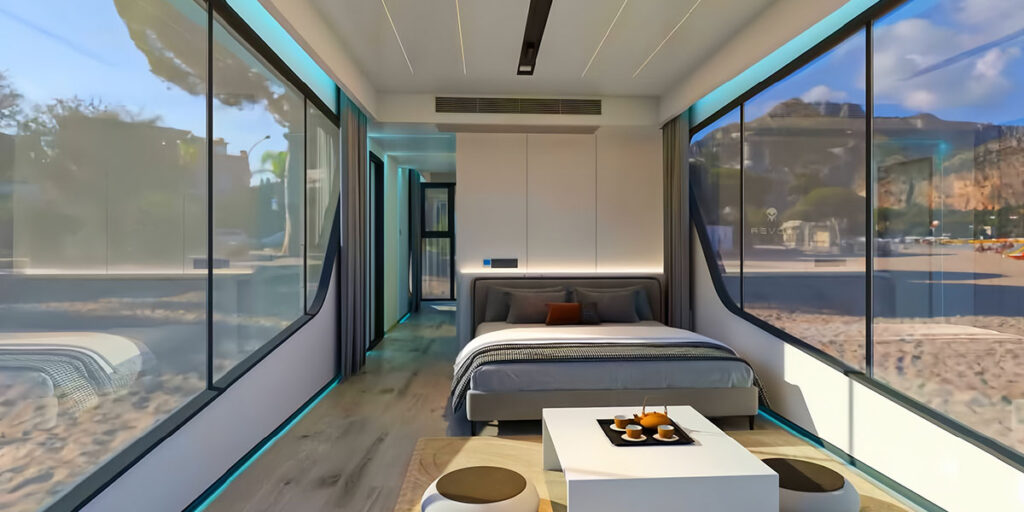
13 Jul Sustainable Capsule House Trends for a Greener Tomorrow
Table of Contents
Imagine a small home that is eco-friendly and modern. Capsule houses change how homes are built by focusing on being green and simple. These smart homes use new designs to save energy and cut waste. For example, modular designs fit into different places and use fewer resources. Smart systems carefully control energy and water use, while reused materials help the planet. Capsule homes also connect with nature—like roofs with plants and big windows that let in lots of sunlight. With recycling rates at 35%, capsule houses show you can live green and stay comfy.
Key Takeaways
Capsule houses are built with green materials like bamboo and reused wood. These materials are strong and cost less.
Smart tools, like IoT gadgets, help save power and make life easier.
Nature-inspired designs, like plants inside and sunlight, boost happiness and make homes peaceful.
Furniture that changes shape or moves makes small spaces useful and cool.
Capsule houses solve city housing problems while being eco-friendly and helping the planet.
Sustainability in Capsule House Design
Eco-Friendly Materials and Construction
Capsule houses use materials that are good for the planet. Bamboo, recycled wood, and eco-friendly composites are common choices. These materials last a long time and cost less. Green roofs and vertical gardens help keep homes warm and manage rainwater better.
Modern building methods make construction smarter. Robots and 3D printers cut waste and build homes more accurately. Homes are made with care and fewer leftovers. Inside, low-VOC paints and recycled wood make the air cleaner. This helps both people and the environment.
Here’s how capsule houses use sustainable materials:
Sustainability Benefit | Description |
|---|---|
Use of innovative materials | Capsule houses use strong, eco-friendly, and affordable materials like recycled ones. |
Modular construction techniques | Robots and 3D printing save materials and improve building accuracy. |
Eco-friendly interior finishes | Low-VOC paints and recycled wood make indoor spaces healthier. |
Energy-Efficient Systems and Renewable Energy
Capsule houses save energy with smart systems like solar panels. Solar panels give clean energy and lower utility costs. Advanced HVAC systems also help reduce energy use and keep homes comfy.
Good insulation is another key feature. Foam and mineral wool keep heat inside and save energy. Smart home devices control lights, heating, and cooling to avoid wasting power. These systems make life better and protect the planet.
Innovations in Water and Waste Management
Capsule houses reuse water with rainwater collection systems. These systems save water for daily tasks and reduce the need for city water. Composting toilets and graywater systems turn waste into useful resources like garden compost or irrigation water.
These homes also focus on health. They improve air quality and avoid harmful chemicals. Sustainable designs make living spaces safer and more comfortable for families.
Smart Technology in Capsule Houses

IoT Features for Energy Optimization
Think of a home that saves energy on its own. IoT, or Internet of Things, makes this possible in capsule houses. These systems track energy use and adjust it instantly. For example, smart thermostats learn your routine and change the temperature to save power. Lights switch off when no one is around, and appliances work during cheaper energy times.
These tools don’t just cut energy use—they simplify life. You can manage everything from your phone, whether you’re home or away. This technology helps you live greener without losing comfort. Capsule houses with IoT show how small homes can make a big difference.
Smart Systems for Compact Living
Living in a capsule house doesn’t mean losing convenience. Smart systems make small spaces useful and fun. Foldable furniture, hidden storage, and multi-use areas adapt to your needs. A dining table can become a desk, or a bed can fold into the wall for more space.
New smart home ideas improve compact living. Here’s how they help:
Feature | Benefit |
|---|---|
Smart Home Features | Lets you control devices with your phone for ease and efficiency. |
Internet of Things (IoT) | Automates appliances and saves energy while improving daily life. |
These systems save time and money. Building costs are lower than regular homes, and construction is faster—up to 40% quicker. You’ll also save 15-20% on total costs by using fewer materials and less labor. Smart systems make capsule houses a smart choice for today’s lifestyle.
AI and Automation Enhancing Sustainability
AI, or artificial intelligence, is changing home design. In capsule houses, AI studies your habits to make spaces fit your needs. It adjusts lights, temperature, and even music based on what you like. This makes your home feel personal while saving energy.
Automation goes further. Imagine a home that waters plants, orders groceries, or cleans itself. These features save time and reduce stress, making life healthier. Automated systems also manage water and electricity to avoid waste.
By combining AI and automation, capsule houses lead in eco-friendly design. They show how technology creates smart, efficient homes that are good for the planet and easy to live in.
Nature-Inspired Capsule House Trends
Biophilic Design Elements
Picture a home that feels like a calm nature escape. Biophilic design brings nature indoors to boost happiness and health. Capsule houses use this idea to make living spaces better. They include things like indoor plants, wooden textures, and even aquariums to relax you.
Research shows nature-like features, such as aquariums or fresh air, improve well-being. Homes with biophilic design also add soothing sounds and natural scents for comfort. For instance, Villa M Hotel in Paris uses green walls and nature-themed rooms to help people sleep and feel calm.
Here’s why biophilic design is important:
It lowers stress and lifts your mood.
It cleans the air with indoor plants.
It connects you to nature, even in cities.
Natural Lighting and Ventilation
Sunlight changes how a home feels. Capsule houses use big windows and skylights to let in light. This cuts down on artificial lighting and saves energy. It also makes your home brighter and more cheerful.
Fresh air is just as vital. Smart designs let air flow naturally, keeping your home cool and fresh. Architects use cross-ventilation to move air around without extra energy. This makes breathing easier and your home healthier.
Natural light and airflow don’t just save power—they help you feel better. Bright rooms and clean air give you more energy and focus. Capsule houses prove simple designs can have a big impact.
Organic and Recycled Materials in Home Design
Capsule houses use eco-friendly materials to help the planet. Recycled wood and bamboo are common choices. These materials are strong, green, and give homes a natural look.
Homes made with these materials aren’t just pretty—they’re safer for you. Low-VOC paints and recycled items keep the air clean inside. Capsule houses also use local materials to lower their carbon footprint.
You can see this trend at Joali Being Resort in the Maldives. They use nature-inspired designs and local materials for a peaceful, green experience. By picking organic and recycled materials, capsule houses lead in sustainable building.
Space-Saving Innovations in Capsule Houses

Modular and Transformable Furniture
Think of furniture that changes to fit your needs. Modular and transformable furniture helps save space in capsule houses. A sofa can become a bed, or a table can fold into the wall. These designs make homes more useful without feeling crowded.
Modular homes use this idea to make small spaces work better. Designers create furniture that does more than one job. For example, storage ottomans hide items and act as seats. Foldable desks and Murphy beds make rooms feel bigger. These smart ideas make every part of your home useful.
Tip: Choose modular furniture with hidden storage. It keeps your capsule house neat and stylish.
Vertical Storage Solutions
When floor space is tight, use the walls. Vertical storage is key for capsule houses. Shelves, cabinets, and racks go up the walls to save room below. This design keeps homes clean and uses space wisely.
Research shows vertical setups work better. For example, Xu et al. found vertical designs save time compared to horizontal ones. Here’s how studies support vertical storage:
Study | Focus | Efficiency Results |
|---|---|---|
Anonymous | Capsule arrangement | Fewer capsules and shorter distances improve efficiency. |
Xu et al. | Orientation comparison | Vertical setups cut operation time significantly. |
These findings show how smart designs improve modular homes. Vertical storage isn’t just helpful—it’s essential for modern living.
Adaptable Designs for Urban and Rural Living
Capsule houses work well in cities and the countryside. Flexible designs make this possible. In cities, modular homes fit small spaces with smart layouts. Rooftop gardens and tiny balconies bring nature to city life.
In rural areas, capsule houses match the environment. Architects use local materials and open designs to connect homes with nature. These layouts adjust to different weather and lifestyles, making them useful anywhere.
Capsule houses show that great design isn’t about size—it’s about smart ideas that fit everywhere.
Capsule Houses in the Global Context
Solving Housing Problems
Think about living in a city where homes cost too much. Capsule houses help fix this issue. These small, modular homes fit into crowded city spaces. They are affordable and smartly designed for people needing a home.
Cities are growing fast, and more people need places to live. Over half of the world’s population lives in cities, and this number keeps rising. Capsule houses solve this problem with eco-friendly designs. They use less space and include energy-saving tools like efficient appliances and water systems. These homes help with housing needs and protect the environment.
Helping Cities Go Green
Capsule houses aren’t just homes—they help cities become greener. Their eco-friendly designs lower the carbon footprint of urban areas. Features like rooftop gardens, solar panels, and rainwater systems make them better for the planet.
Cities using capsule houses set a good example. Compact designs save land, and modular building reduces waste. This helps create parks and green spaces for people to enjoy. Capsule houses prove cities can grow without harming nature.
Supporting Global Green Goals
Capsule houses match global goals for sustainability. Their modular designs use fewer resources, and their energy-saving systems cut pollution. Using recycled and local materials helps the planet and supports a circular economy.
Capsule houses also support the United Nations’ Sustainable Development Goals (SDGs). They focus on affordable housing, green cities, and fighting climate change. Choosing a capsule house means you’re helping the world become cleaner and healthier.
Capsule houses are changing how we think about sustainable homes. Their modular designs make them cheaper, smarter, and better for the planet. By 2025, these homes will focus on stylish looks, cool tech, and healthier spaces. Governments want energy-saving ideas, and high energy prices push people to use smarter systems.
These homes are more than just places to live—they help the planet. Features like touch-free gadgets and clever layouts make them comfy and green. Picking a capsule house means choosing a future where buildings work with nature, not against it.
Tip: Modular homes are great for saving money, living green, and enjoying modern designs.
FAQ
What makes capsule houses eco-friendly?
Capsule houses use recycled materials, solar panels, and rainwater systems. They are built to save energy and cut waste. With smart tech and small designs, they help the planet while staying cozy.
Can capsule houses work in cold or hot climates?
Yes! Capsule houses have insulation and smart airflow for tough weather. Solar panels and energy-saving systems keep them warm in winter and cool in summer. They easily adjust to your local weather.
Are capsule houses affordable?
Yes! Capsule houses cost less to build and take care of. Modular designs use fewer materials and less labor. Energy-saving systems also lower your bills, making them a smart, budget-friendly choice.
How long does it take to build a capsule house?
Building a capsule house is fast—about 40% quicker than normal homes. Modular building and 3D printing make the process faster. You could move in within weeks!
Can capsule houses be customized?
Yes! You can pick layouts, materials, and smart features to match your style. Want a rooftop garden or foldable furniture? Capsule houses let you design a home that’s just right for you.
Tip: Plan for your needs when designing. A little thought makes your capsule house perfect!



